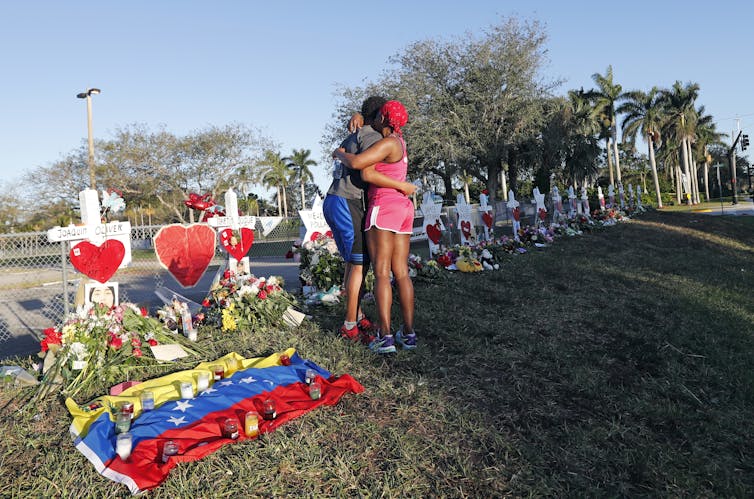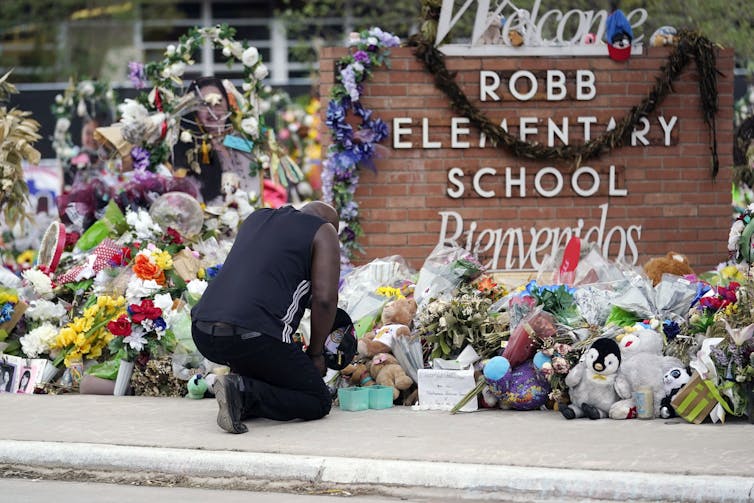5 years after Parkland, school shootings continue
David Riedman, University of Central Florida; James Densley, Metropolitan State University , and Jillian Peterson, Hamline University
 |
| Two mourners embrace at a memorial for those killed in the Parkland, Florida, school shooting in 2018. AP Photo/Gerald Herbert |
Despite the outpouring of grief and calls for action that followed the shooting at Marjory Stoneman Douglas High School, school shootings continue to occur with alarming frequency.
While progress has been made in some areas, such as increased funding for school security and mental health resources, there is still much work to be done to ensure the safety and well-being of students and educators in schools across the country.
On Jan. 6, 2023, in Newport News, Virginia, a 6-year-old student is alleged to have intentionally shot his teacher. He is among the youngest school shooting perpetrators dating back to 1970.
And as criminologists who track any time a gun is fired at a K-12 school, including deliberate attacks, suicides, accidental shootings, gang-related violence and shootings at after-hours school events, we know this case is only the tip of the iceberg.
School shootings got more common, not rarer, after Parkland
Since Parkland, there have been over 900 shootings in K-12 school settings according to our data. Thirty-two were indiscriminate attacks apparently driven by the intent to kill as many people as possible, including mass casualty events at Robb Elementary School in Uvalde, Texas, in May 2022 and at Oxford High School, in Oxford, Michigan, in November 2021.
School gun violence takes many forms. In January 2023, five students were wounded during shootings at high school basketball games in five different states.
These shootings at school games are a “quiet phenomenon” that gets little national attention. Based on our data on more than 260 shootings at sports events, most schools do not have a plan for them, such as what an announcer should say or how people can evacuate.
Another emerging challenge for school leaders is the 264 fights in five years that escalated into shootings. Unlike any planned attacks, these cases were simple disputes that turned deadly because students were armed at school.
There were a record 302 shootings on school property in 2022. In April, one month before Uvalde, a sniper fired hundreds of shots during dismissal at the Edmund Burke School in Washington, D.C.
Then, in October, at Central Visual Performing Arts High School in south St. Louis, a 19-year-old armed with a semi-automatic rifle and hundreds of rounds of ammunition shot and killed a teacher and a 15-year-old student, and injured seven other people.
Among the 250 shootings at schools in 2021, a 12-year-old girl, who wrote plans to target scores of her Rigby, Idaho, middle school classmates, wounded three students before a heroic teacher disarmed her in the hallway.
 |
| A man pays his respects to the victims of the June 2022 school shooting in Uvalde, Texas. AP Photo/Eric Gay |
In total, since Parkland, 198 people have been killed, including 84 students, teachers and school staff, and another 637 people wounded in school shootings.
Equipment is not prevention
Since Parkland, school safety has been a priority for parents and policymakers, but efforts to physically fortify schools to keep intruders at bay often are detached from the reality that most school shooters are current or former students of the schools they target.
Having been trained in lockdown procedures since kindergarten, students know exactly how a school will respond to an active shooter and even plan for it; they navigate security daily. At Uvalde, the shooter was a former student who entered through a back door. The shooter in St. Louis was a former student who broke a side window to open a locked door.
New equipment designed to protect students from shooters can create a false sense of security and make classrooms feel more like prisons than places of learning. Following the attack in Uvalde, Texas legislators approved $110 million for school safety, but nearly half of the money went to new ballistic shields for school police officers.
These shields do not prevent school shootings, or aid during one, because police are trained to immediately run to the shooter, not to their office to get a shield.
Some technologies could even inadvertently endanger students. Most classroom barricades violate the Americans with Disabilities Act and other federal codes designed to help people evacuate from fires and other dangerous situations. And much like body armor can make a mass shooter harder to stop, so too, potentially, could a school’s new bulletproof furniture.
Preventing the next Parkland
Just three weeks before Parkland, on Jan. 23, 2018, 20 students were shot, two fatally, in a planned attack at Marshall County High in Benton, Kentucky. Three months after Parkland, on May 18, 2018, 10 people were killed and 13 wounded at Santa Fe High School in Santa Fe, Texas.
Despite billions spent on security upgrades, schools are stuck in a perpetual cycle of gun violence. If current trends hold, there will be another 1,000 school shootings over the next five years.
But research shows that school shootings are not inevitable. They are preventable.
Nearly all school shooters exhibit warning signs before pulling the trigger, from changes in their behavior to verbal or written threats. From Parkland to Uvalde, these warnings were not recognized or reported until it was too late.
Schools must think beyond metal detectors, security cameras and other high-tech gadgets and gizmos to invest in multidisciplinary behavioral intervention and threat assessment systems to respond to warning signs.
There is federal money and resources available to do this thanks to the Bipartisan Safer Communities Act, passed in the wake of Uvalde in the summer of 2022.
Almost all shootings by children and teens can be prevented by safe storage of firearms and accountability for adult gun owners. When a weapon is stored separately from its ammunition, locked and unloaded, it is much more difficult for someone to quickly use it in a violent attack.
While the family claims the gun was locked, safe and separate storage could have prevented a 6-year-old from shooting his teacher. It also could have prevented thousands of guns from being stolen and diverted into illegal markets.
Five years after Parkland, school shootings have become more frequent and deadly. The status quo is not working. Instead of accepting that more young lives will be lost and that the best schools and police can do is lock down and rehearse emergency responses, we believe school safety must shift to focus on upstream prevention.![]()
David Riedman, Ph.D. student in Criminal Justice and Creator of the K-12 School Shooting Database, University of Central Florida; James Densley, Professor of Criminal Justice, Metropolitan State University , and Jillian Peterson, Professor of Criminal Justice, Hamline University
This article is republished from The Conversation under a Creative Commons license. Read the original article.